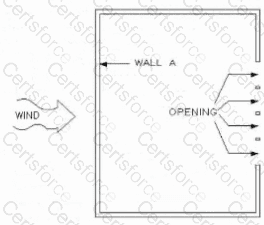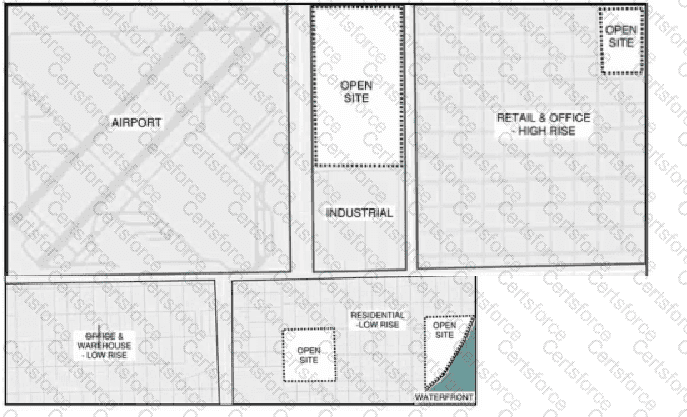An elementary school requires a renovation, selective demolition, and a major addition in order to accommodate a growing student population. An architectural firm has prepared schematic design plans incorporating the school's increased programmatic needs, including an enlarged library, cafeteria, and gymnasium; a secure courtyard; and additional space for administrative offices and classrooms. The main entrance was relocated in order to improve the traffic and pedestrian flow at the beginning and end of the school day, and additional parking was provided to comply with current zoning requirements.
The existing single-story masonry building was built in 1950. Two small additions were built later: the north addition will be kept and repurposed, but the south addition will be demolished. The building contains asbestos and lead in roof soffits, floor tiles, pipe insulation, and window paint. All existing mechanical systems need to be replaced; new systems have not been selected.
Considerations for the renovation include:
•The relocated front entrance must be easily recognizable, highly visible, and secure.
•Interior and exterior materials need to be durable and maintainable in order to withstand frequent student abuse, but also economical due to strict budget limitations.
•Good indoor air quality and increased energy efficiency are priorities for the selection of mechanical equipment.
After completion, the entire school should look uniform, without a distinctive difference between the existing building and new addition.
Building information:
•Construction Type is II-B.
The following resources are available for your reference:
•Existing Plans, including site and floor plans
•Proposed Plans, including site and floor plans
•Cost Analysis
•Zoning Ordinance Excerpts, for off-street parking requirements
•IBC Excerpts, showing relevant code sections
•ADA Standards Excerpts, showing relevant sections from the ADA Standards for Accessible Design
An elementary school library has an occupancy load of 150.
What is the minimum clear opening width required?
Which of the following is the most appropriate action for the architect to take in preparing a construction cost estimate for an owner after completing the schematic design phase?
Program requirements for a hospital with a clear span of 70 feet include minimal disruption of the hospital routine for future mechanical and electrical repairs and alterations and a maximum economical flexibility of the structure.
Which of the following structural systems is most appropriate?

Refer to the exhibit (table showing energy embodied and annual energy demand for Type L and Type H walls).
In the table, Type L wall is lightly insulated and Type H wall is heavily insulated. Approximately how many heating seasons would it take to recover the extra energy involved in selecting the Type H construction?
An elementary school requires a renovation, selective demolition, and a major addition in order to accommodate a growing student population. An architectural firm has prepared schematic design plans incorporating the school's increased programmatic needs, including an enlarged library, cafeteria, and gymnasium; a secure courtyard; and additional space for administrative offices and classrooms. The main entrance was relocated in order to improve the traffic and pedestrian flow at the beginning and end of the school day, and additional parking was provided to comply with current zoning requirements.
The existing single-story masonry building was built in 1950. Two small additions were built later: the north addition will be kept and repurposed, but the south addition will be demolished. The building contains asbestos and lead in roof soffits, floor tiles, pipe insulation, and window paint. All existing mechanical systems need to be replaced; new systems have not been selected.
Considerations for the renovation include:
•The relocated front entrance must be easily recognizable, highly visible, and secure.
•Interior and exterior materials need to be durable and maintainable in order to withstand frequent student abuse, but also economical due to strict budget limitations.
•Good indoor air quality and increased energy efficiency are priorities for the selection of mechanical equipment.
After completion, the entire school should look uniform, without a distinctive difference between the existing building and new addition.
Building information:
•Construction Type is II-B.
The following resources are available for your reference:
•Existing Plans, including site and floor plans
•Proposed Plans, including site and floor plans
•Cost Analysis
•Zoning Ordinance Excerpts, for off-street parking requirements
•IBC Excerpts, showing relevant code sections
•ADA Standards Excerpts, showing relevant sections from the ADA Standards for Accessible Design
The project team decides to cover the roof area above the gymnasium and platform with 350 watt, stationary, photovoltaic (PV) panels. Each panel requires 20 square feet, accounting for access aisles and safety clearances. The PV system will be tied to the local power company's electrical grid, and will not have battery storage. The school is located in a region that gets an average of 4 usable hours of sunlight per day.
Which of the following PV system design considerations apply to this project? Check the three that apply.
Refer to the project involving an elementary school renovation and addition with photovoltaic (PV) panels on the gymnasium roof (350-watt panels, 20 sq ft each, ~4 usable sunlight hours/day). The PV system is grid-tied without battery storage.
Which of the following PV system design considerations apply? Check the three that apply.
An elementary school requires a renovation, selective demolition, and a major addition in order to accommodate a growing student population. An architectural firm has prepared schematic design plans incorporating the school's increased programmatic needs, including an enlarged library, cafeteria, and gymnasium; a secure courtyard; and additional space for administrative offices and classrooms. The main entrance was relocated in order to improve the traffic and pedestrian flow at the beginning and end of the school day, and additional parking was provided to comply with current zoning requirements.
The existing single-story masonry building was built in 1950. Two small additions were built later: the north addition will be kept and repurposed, but the south addition will be demolished. The building contains asbestos and lead in roof soffits, floor tiles, pipe insulation, and window paint. All existing mechanical systems need to be replaced; new systems have not been selected.
Considerations for the renovation include:
The relocated front entrance must be easily recognizable, highly visible, and secure.
Interior and exterior materials need to be durable and maintainable in order to withstand frequent student abuse, but also economical due to strict budget limitations.
Good indoor air quality and increased energy efficiency are priorities for the selection of mechanical equipment.
After completion, the entire school should look uniform, without a distinctive difference between the existing building and new addition.
Building information:
Construction Type is II-B.
The following resources are available for your reference:
Existing Plans, including site and floor plans
Proposed Plans, including site and floor plans
Cost Analysis
Zoning Ordinance Excerpts, for off-street parking requirements
IBC Excerpts, showing relevant code sections
ADA Standards Excerpts, showing relevant sections from the ADA Standards for Accessible Design

Refer to the exhibit (building with wind impacting wall A, and openings shown).
For the building subjected to wind as shown, the design pressure acting on the interior face of wall A would be what?
An architect is developing a master plan for a small area of a city located on a lake. The master plan has four open sites being considered for a proposed park. The city needs to avoid incoming noise pollution at the park and provide a variety of activities for the city.
Click on the open site that is appropriate for a city park with baseball fields and nature trails.

The architect's greatest contribution to good seismic design is in the design of which of the following?
Which statement accurately describes the use of an electrical conduit?